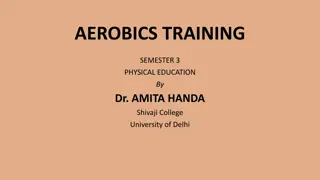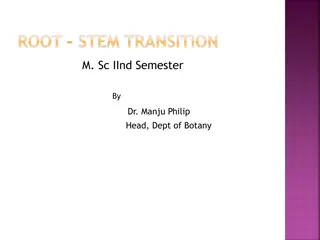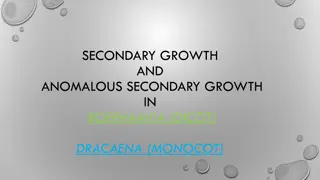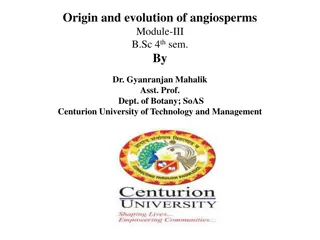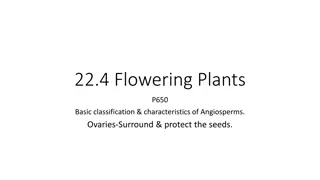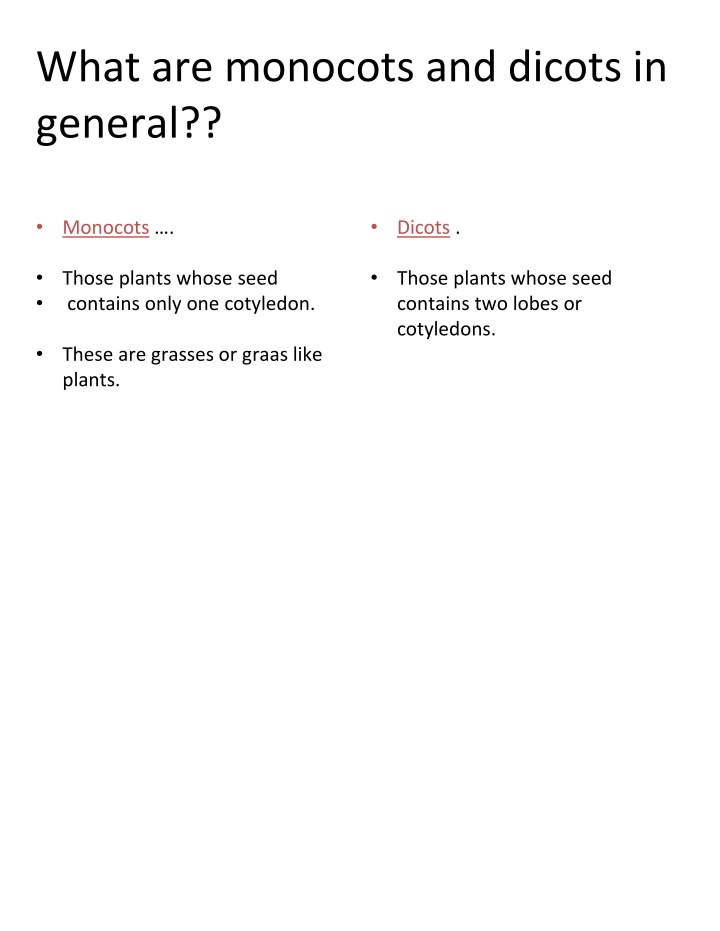
Monocots and Dicots in Plant Classification
Learn about monocots and dicots, two broad categories of plants based on the number of cotyledons in their seeds. Explore the anatomy of dicot stems and roots, including the epidermis, cortex, endodermis, and stele. Gain insights into the primary structures and functions of dicot plants.
Download Presentation

Please find below an Image/Link to download the presentation.
The content on the website is provided AS IS for your information and personal use only. It may not be sold, licensed, or shared on other websites without obtaining consent from the author. If you encounter any issues during the download, it is possible that the publisher has removed the file from their server.
You are allowed to download the files provided on this website for personal or commercial use, subject to the condition that they are used lawfully. All files are the property of their respective owners.
The content on the website is provided AS IS for your information and personal use only. It may not be sold, licensed, or shared on other websites without obtaining consent from the author.
E N D
Presentation Transcript
What are monocots and dicots in general?? Monocots . Dicots . Those plants whose seed contains only one cotyledon. Those plants whose seed contains two lobes or cotyledons. These are grasses or graas like plants.
Primary structure of Dicot stem: ANATOMY OF DICOT STEM - DEFINITION 1.Epidermis It is a protective outermost single layer of parenchymatous cells without intercellular spaces. The outer walls of the epidermal cells have a layer called cuticle and multicellular hairs (trichomes). 2.Cortex
Below the epidermis, cortex is differentiated into few layers of collenchyma cells that make hypodermis which gives mechanical strength to the stem. A few layers of chlorenchyma cells are present with conspicuous intercellular spaces. Some resin ducts also occur here. The third zone is made up of parenchyma cells. These cells store food materials. 3.Endodermis: The cells of this layer are barrel shaped arranged compactly without intercellular spaces. Due to abundant starch grains in these cells, this layer is also known as starch sheath. 3.Stele It consists of pericycle, vascular bundles and pith. A)Pericycle(Bundlecap) Pericycle occurs between the endodermis and vascular bundles in the form of a few layers of sclerenchyma cells. B)Vascularbundles In dicot stem, vascular bundles are arranged in a ring around the pith. Each vascular bundle is conjoint, collateral, open and endarch. C)Pith The large central portion called pith composed of parenchyma cells with intercellular spaces. The extension of pith between vascular bundles are called as pith ray or medullary rays.
Function of the pith is storage of food. Primary structure of dicot root: Epidermis: It is single-layered and composed of thin- walled cells. The outer walls of epidermal cells are not cutinised. Many epidermal cells prolong to form long hairy bodies, the typical unicellular hairs of roots. Epidermis of root is also called epiblema or piliferous layer (pilus = hair; ferous bearing). II. Cortex: Itis quitelarge andextensiveinroots.Cortexis madeof thin-walled living parenchymatous cells with leucoplasts, which convert sugar into starch grains. The last layer of cortex is endodermis. It is of universal occurrence in roots. Endodermis is composed of one layer of barrel-shaped cells which are closely arranged without having intercellular spaces. The endodermal cells have thickened radial walls, which are called Casparian strips, after the name of Caspary, the gentleman who first noted them.
III. Stele or Central Cylinder: Next to endodermis there is a single-layered pericycle made up of thin- walled parenchyma cells. Pericycle is the seat of the origin of lateral roots. Vascular bundles are typically radial in roots. Xylem and phloem form separate patches and are intervened by non-conducting cells. In dicotyledonous roots the number of bundles is limited. Xylem has protoxylem towards circumference abutting on pericycle and metaxylem towards centre. This is called exarch arrangement (of endarch arrangement of stems). Phloem with sieve tubes, etc., form patches
arranged alternately with xylem. A small patch of sclerenchyma cells is present outside every group of phloem. Conjunctive Tissue: Thin-walled parenchymatous cells lying in between xylem and phloem groups constitute the conjunctive tissue. Pith: At the centre there is a small parenchymatous pith. It may be even absent in dicotyledonous roots. Anatomy of monocot stem: 1.Epidermis
It is the outermost layer made up of single layer of tightly packed parenchymatous cells withthickcuticle. There are no epidermal outgrowths. 2.Hypodermis A few layer of sclerenchymatous cells lying below the epidermis constitute thehypodermis,givesmechanical strengthto the plant. 3. Ground tissue It is not differentiated into cortex, endodermis, pericycle andpith. The ground tissue is represented by several layers of loosely arranged parenchymacells enclosingprominentintercellularspaces. Thegroundtissueis meant for storageof food. Vascularbundles Vascularbundlesare scatteredin the parenchymatous groundtissue. Vascularbundlesare numerous,small and closelyarrangedin the peripheral portion. Towards the centre, the bundles are comparatively large in size and loosely arranged. Each vascular bundle is surrounded by a sheath of sclerenchymatous fibrescalledbundlesheath. The vascularbundles are conjoint,collateral, endarch and closed. Phloem: The phloem in the monocot stem consists of sieve tubes and companion cells. Phloemparenchyma and phloemfibres are absent. Xylem:
The two metaxylem vessels are located at the upper two arms and one or two protoxylemvessels at the base. (Yshaped) In a mature bundle, the lowest protoxylemdisintegrates and forms a cavity knownasprotoxylemlacuna. Anatomy of monocot root: Epidermis/Epiblema/Rhizodermis: It is the outermost layer composed of compact parenchymatous cells having no intercellular spaces and stomata. The tubular unicellular root hairs are also present on this layer Both epiblema and root hairs are without cuticle. In older parts, epiblemma either becomes impervious or is shed. Epiblemma and root hairs absorb water and mineral salts. Cortex: It lies just below the epidermis. Cortex consists of thin walled multilayered parenchyma cells having sufficiently developed intercellular spaces among them. Usually in an old root of Zea mays, a few layers of cortex undergo suberization and give rise to a single or multi-layered zone- the exodermis. This is a protective layer which protects internal tissues from outer injurious agencies. The starch grains are abundantly present in the cortical cells.
Cortex functions : a) conduction of water and mineral salts from root hairs to inner tissues b) storage of food c) protection when exodermis is formed in older parts. Endodermis: The innermost layer of the cortex is termed as endodermis. It is composed of barrel-shaped compact cells that lacks intercellular spaces among them. Young endodermal cells have an internal strip of suberin and lignin which is called casparian strip. The strip is located close to the inner tangential wall. There are some unthickened cells opposite to the protoxylem vessels known as passage cells which serve for conducting of fluids. The function of endodermis is to regulate the flow of both inward as well as outward. Pericycle: It lies just below the endodermis and is composed of single layered sclerenchymatous cells intermixed with parenchyma. Vasculartissue: Thevasculartissuecontainsalternating strandsofxylem andphloem. The phloem is visualized in the form of strands near the periphery of the vascular cylinder, beneath the pericycle. The xylem forms discrete strands, alternating with phloem strands.
The center is occupied by large pith which maybe parenchymatous or sclerenchymatous. The number of vascular bundles is more than six, hence called as polyarch. Xylem is exarch i.e. the protoxylem is located towards the periphery and the metaxylem towards the center. Vessels of protoxylem are narrow and the walls possess annular and spiral thickenings in contrast, metaxylem are broad and the walls have reticulate and pitted thickenings. Phloem strands consist of sieve tubes, companion cells and phloem parenchyma. The phloem strands are also exarch having protophloem towards the periphery and metaphloem towards the center. Conjunctive tissues: In between the xylem and phloem bundles, there is the presence of many layered parenchymatous or sclerenchymatous tissue. These help in storage of food and help in mechanical support. Pith: It is the central portion usually composed of thin-walled parenchymatous cells which appear polygonal or rounded in T.S. Intercellular spaces may or may not be present amongst pith cells. In some cases pith becomes thick walled and lignified. Pith cells serve to store food. Monocot Root T. S.
Secondary Growth in Dicot Stem of plants. Primary growth produces growth in length and development of lateral appendages. Secondary growth is the formation of secondary tissues from lateral meristems. It increases the diameter of the stem. In woody plants, secondary tissues constitute the bulk of the plant. They take part in providing protection, support and conduction of water and nutrients.
1.Anatomy of Monocot Leaf Epidermis: 1.Two epidermal layers are present, one each on upper and lower surfaces. 2.Uniseriate upper and lower epidermal layers are composed of more or less oval cells. 3.Few big, motor cells or bulliform cells are present in groups here and there in the furrows of upper epidermis. 4.Stomata, each consisting of a pore, guard cells and a stomatal chamber, are present on both the epidermal layers. 5. Athick cuticle is present on the outer walls of epidermal cells. 6. Bulliform cells help folding of leaves. Mesopbyll: 7.It is not clearly differentiated into palisade and spongy parenchyma but the cells just next to the epidermal layers are a bit longer while the cells of the central mesophyll region are oval and irregularly arranged. 8. The cells are filled with many chloroplasts. 9. Many intercellular spaces are also present in this region. 10. Sub-stomatal chambers of the stomata are also situated in this region. VascularSystem: 11.Many vascular bundles are present. They are arranged in a parallel series.
12. The central vascular bundle is largest in size. 13. Vascular bundles are conjoint, collateral and closed. 14.Each vascular bundle remains surrounded by a double-layered bundle sheath. 15.Outer layer of bundle sheath consists of thin-walled cells while the inner layer is made up of thick-walled cells. 16.On the upper as well as lower surfaces of large vascular bundles are present patches of sclerenchyma which are closely associated with the epidermal layers. There is no such association between the sclerenchyma and small vascular bundles. 17.Xylem occurs towards the upper surface and phloem towards to lower surface. 18.Xylem consists of vessels and tracheids. Sometimes small amount of xylem parenchyma is also present. 19. Phloem consists of sieve tubes and companion cells. Xerophytic Characters: (i) Thick cuticle on epidermis. (ii) Presence of motor cells. (iii) Sclerenchyma patches are present. (iv) Stomata in furrows.
Anatomy of Dicot Leaf: Epidermis: 1. An epidermal layer is present on the upper as well as lower surfaces. 2.One-celled thick upper and lower epidermal layers consist of barrel- shaped, compactly arranged cells. 3.A thick cuticle is present on the outer walls of epidermal cells. Comparatively, thick cuticle is present on the upper epidermis. 4. Stomata are present only on the lower epidermis. Mesophyil: 5. It is clearly differentiated into palisade and spongy parenchyma. 6.Palisade lies just inner to the upper epidermis. It is composed of elongated cells arranged in two layers.
7.The cells of palisade region are compactly arranged and filled with chloroplasts. At some places the cells are arranged loosely and leave small and big intercellular spaces. 8.Palisade cells are arranged at a plane at right angle to the upper epidermis, and the chloroplasts in them are arranged along their radial walls. 9.Parenchymatous cells are present above and below the large vascular bundles. These cells interrupt the palisade layers and are said to be the extensions of the bundle sheath. 10.Spongy parenchyma region is present just below the palisade and extends upto the lower epidermis. 11.The cells of spongy parenchyma are loosely arranged, filled with many chloroplasts and leave big intercellular spaces. VascularRegion: 12. Many large and small vascular bundles are present. 13. Vascular bundles are conjoint, collateral and closed. 14. Each vascular bundle is surrounded by a bundle sheath. 15.Bundle sheath is parenchymatous and in case of large bundles it extends upto the epidermis with the help of thin-walled parenchymatous cells. 16.The xylem is present towards the upper epidermis and consists of vessels and xylem parenchyma. Protoxylem is present towards upper epidermis while the metaxylem is present towards the lower epidermis. 17.Phloem is situated is present towards the lower epidermis and consists of sieve tubes, companion cells and phloem parenchyma.





